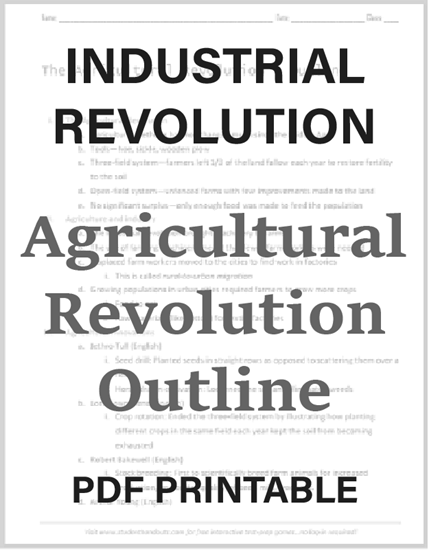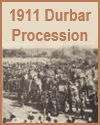| Agricultural Revolution Printable PDF Outline |
|---|
| www.studenthandouts.com ↣ World History ↣ Industrial Revolution ↣ Industrial Revolution Outlines & PPTs |
Here is a free printable outline of the Agricultural Revolution in the West which occurred in the 18th and 19th centuries, in conjunction with the Industrial Revolution. This outline is suited for high school-level (and up) teachers and students of World History, Global Studies, and European History (both AP and general education courses). Scroll down for a printable version (.pdf file). I. The Agricultural Revolution
I. The Agricultural Revolutiona. Agricultural methods had not changed much since the Middle Ages b. Tools—hoe, sickle, wooden plow c. Three-field system—farmers left 1/3 of the land fallow each year to restore fertility to the soil d. Open-field system—unfenced farms with few improvements made to the land e. No significant surplus—only enough food was made to feed the population II. Agriculture and industry a. The Industrial Revolution brought machinery to farms b. The use of farming machinery meant that fewer farm workers were needed c. Displaced farm workers moved to the cities to find work in factories i. This is called rural-to-urban migration d. Growing populations in urban cities required farmers to grow more crops i. Food to eat ii. Raw materials (like cotton) for textile factories III. Agricultural innovations a. Jethro Tull (English) i. Seed drill: Planted seeds in straight rows as opposed to scattering them over a field ii. Horse-drawn cultivation: Loosened the soil and eliminated weeds b. Lord Townshend (English) i. Crop rotation: Ended the three-field system by illustrating how planting different crops in the same field each year kept the soil from becoming exhausted c. Robert Bakewell (English) i. Stock breeding: First to scientifically breed farm animals for increased production, and better quality, of beef, milk, wool, etc. d. Arthur Young (English) i. Agricultural writer: Popularized new farming methods and machinery e. Justus von Liebig (German) i. Fertilizers: Invented fertilizers to enrich exhausted soil, which increased the amount of available farmland IV. Agricultural machinery a. Eli Whitney i. Cotton gin (1793)—increased cotton production b. Cyrus McCormick i. Mechanical reaper (1834)—increased wheat production c. Other important inventions—horse-drawn hay rake, threshing machine, steel plow d. Steam engines, gasoline diesel engines, and electric motors were added to farm machinery as these types of engines were invented e. The Industrial Revolution and Agricultural Revolution complemented one another i. Developments and needs in one created developments and needs in the other V. Agricultural science a. Agriculture became a science during the Agricultural Revolution b. Farmers and governments invested in agricultural research i. Established agricultural schools, societies, and experimental stations c. Progress in agriculture i. Pesticides, stock breeding, new foods, food preservation, new farming techniques and irrigation methods, frozen foods d. Result i. Today, in the industrialized world, much more food is grown by far fewer farmers than was grown 200 years ago (or is grown today in the non-industrialized world) VI. Review questions a. Describe three features of agriculture before the Agricultural Revolution. b. How did agricultural machinery change farm labor? c. Describe the inventions or methods of at least three agricultural innovators. d. Weigh the pros and cons of modern agriculture's use of pesticides, preservation, and stock breeding. Click here to print. |
 |  |  |  |  |
| www.studenthandouts.com ↣ World History ↣ Industrial Revolution ↣ Industrial Revolution Outlines & PPTs |








